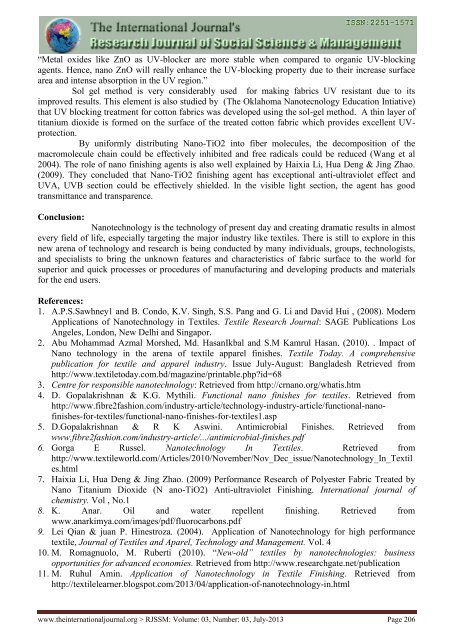Research Journal of Social Science & Management - RJSSM - The ...
Research Journal of Social Science & Management - RJSSM - The ...
Research Journal of Social Science & Management - RJSSM - The ...
Create successful ePaper yourself
Turn your PDF publications into a flip-book with our unique Google optimized e-Paper software.
“Metal oxides like ZnO as UV-blocker are more stable when compared to organic UV-blocking<br />
agents. Hence, nano ZnO will really enhance the UV-blocking property due to their increase surface<br />
area and intense absorption in the UV region.”<br />
Sol gel method is very considerably used for making fabrics UV resistant due to its<br />
improved results. This element is also studied by (<strong>The</strong> Oklahoma Nanotecnology Education Intiative)<br />
that UV blocking treatment for cotton fabrics was developed using the sol-gel method. A thin layer <strong>of</strong><br />
titanium dioxide is formed on the surface <strong>of</strong> the treated cotton fabric which provides excellent UVprotection.<br />
By uniformly distributing Nano-TiO2 into fiber molecules, the decomposition <strong>of</strong> the<br />
macromolecule chain could be effectively inhibited and free radicals could be reduced (Wang et al<br />
2004). <strong>The</strong> role <strong>of</strong> nano finishing agents is also well explained by Haixia Li, Hua Deng & Jing Zhao.<br />
(2009). <strong>The</strong>y concluded that Nano-TiO2 finishing agent has exceptional anti-ultraviolet effect and<br />
UVA, UVB section could be effectively shielded. In the visible light section, the agent has good<br />
transmittance and transparence.<br />
Conclusion:<br />
Nanotechnology is the technology <strong>of</strong> present day and creating dramatic results in almost<br />
every field <strong>of</strong> life, especially targeting the major industry like textiles. <strong>The</strong>re is still to explore in this<br />
new arena <strong>of</strong> technology and research is being conducted by many individuals, groups, technologists,<br />
and specialists to bring the unknown features and characteristics <strong>of</strong> fabric surface to the world for<br />
superior and quick processes or procedures <strong>of</strong> manufacturing and developing products and materials<br />
for the end users.<br />
References:<br />
1. A.P.S.Sawhney1 and B. Condo, K.V. Singh, S.S. Pang and G. Li and David Hui , (2008). Modern<br />
Applications <strong>of</strong> Nanotechnology in Textiles. Textile <strong>Research</strong> <strong>Journal</strong>: SAGE Publications Los<br />
Angeles, London, New Delhi and Singapor.<br />
2. Abu Mohammad Azmal Morshed, Md. HasanIkbal and S.M Kamrul Hasan. (2010). . Impact <strong>of</strong><br />
Nano technology in the arena <strong>of</strong> textile apparel finishes. Textile Today. A comprehensive<br />
publication for textile and apparel industry. Issue July-August: Bangladesh Retrieved from<br />
http://www.textiletoday.com.bd/magazine/printable.php?id=68<br />
3. Centre for responsible nanotechnology: Retrieved from http://crnano.org/whatis.htm<br />
4. D. Gopalakrishnan & K.G. Mythili. Functional nano finishes for textiles. Retrieved from<br />
http://www.fibre2fashion.com/industry-article/technology-industry-article/functional-nan<strong>of</strong>inishes-for-textiles/functional-nano-finishes-for-textiles1.asp<br />
5. D.Gopalakrishnan & R K Aswini. Antimicrobial Finishes. Retrieved from<br />
www.fibre2fashion.com/industry-article/.../antimicrobial-finishes.pdf<br />
6. Gorga E Russel. Nanotechnology In Textiles. Retrieved from<br />
http://www.textileworld.com/Articles/2010/November/Nov_Dec_issue/Nanotechnology_In_Textil<br />
es.html<br />
7. Haixia Li, Hua Deng & Jing Zhao. (2009) Performance <strong>Research</strong> <strong>of</strong> Polyester Fabric Treated by<br />
Nano Titanium Dioxide (N ano-TiO2) Anti-ultraviolet Finishing. International journal <strong>of</strong><br />
chemistry. Vol , No.1<br />
8. K. Anar. Oil and water repellent finishing. Retrieved from<br />
www.anarkimya.com/images/pdf/fluorocarbons.pdf<br />
9. Lei Qian & juan P. Hinestroza. (2004). Application <strong>of</strong> Nanotechnology for high performance<br />
textile, <strong>Journal</strong> <strong>of</strong> Textiles and Aparel, Technology and <strong>Management</strong>. Vol. 4<br />
10. M. Romagnuolo, M. Ruberti (2010). “New-old” textiles by nanotechnologies: business<br />
opportunities for advanced economies. Retrieved from http://www.researchgate.net/publication<br />
11. M. Ruhul Amin. Application <strong>of</strong> Nanotechnology in Textile Finishing. Retrieved from<br />
http://textilelearner.blogspot.com/2013/04/application-<strong>of</strong>-nanotechnology-in.html<br />
www.theinternationaljournal.org > <strong>RJSSM</strong>: Volume: 03, Number: 03, July-2013 Page 206

















